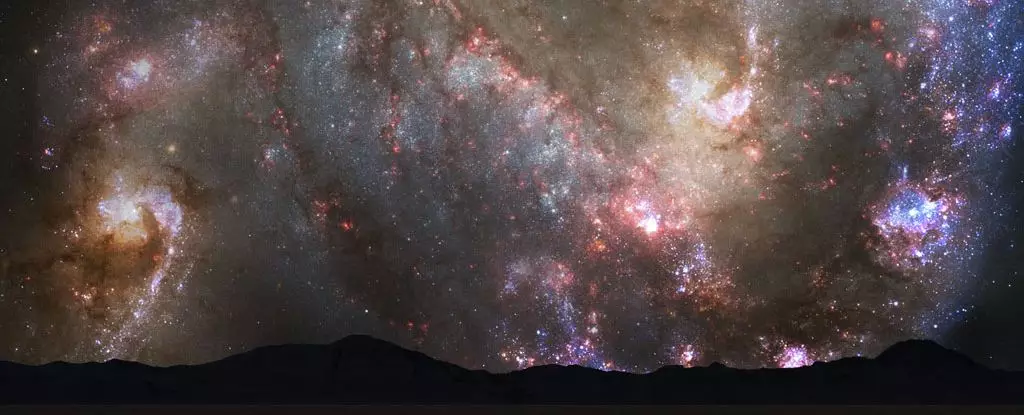The cosmos is a stage of grandiosity, with our Milky Way Galaxy playing a leading role alongside its neighboring Andromeda Galaxy. For years, scientists have heralded the impending collision between these two colossal structures as an inevitable climax of galactic evolution. However, recent investigations led by Till Sawala and his team at the University of Helsinki suggest that the narrative may be more nuanced than previously thought. Their findings indicate that the anticipated cataclysmic union of Milky Way and Andromeda—often referred to as “Milkomeda”—is not a foregone conclusion. Instead, researchers now posit that the chances of a collision versus a near miss are remarkably balanced.
The Scientific Method: Revisiting Assumptions
At the heart of this inquiry lies a revisitation of empirical models and assumptions that have driven earlier predictions. By leveraging advanced data courtesy of the Hubble and Gaia space telescopes, Sawala’s team recalibrated existing models to account for not just the two principal players—Milky Way and Andromeda—but also the entire Local Group of galaxies they inhabit. This group includes not only the sizable spirals but also smaller but significant galaxies like the Triangulum (M33) and the Large Magellanic Cloud (LMC). The addition of these variables into simulation models drastically alters the picture and illustrates the intricate dynamics at play within our galactic neighborhood.
Sawala emphasized the importance of understanding collective interactions by stating, “There is actually a lot of complexity and uncertainty even in the relatively simple three- or four-body systems.” Analyzing these gravitational relationships unveils essential insights into the probable trajectories of these galaxies over the next ten billion years—a period so expansive that it invites both awe and skepticism regarding predictability.
Simulations and Probabilities: A New Perspective
The simulations run by Sawala and his colleagues yield surprising results: a mere chance of nearly 50% for collision versus as much likelihood of gravitational evasiveness. Initially, in simulations considering just the Milky Way and Andromeda, merger probabilities hovered around 50%. However, when factoring in the presence of M33, the probability tipped toward approximately two in three. In contrast, introducing LMC did the opposite, dragging the probability down to roughly one in three. When all four galaxies were considered, the forecast slightly favored a collision.
These findings urge us to reconsider how the interplay of cosmic forces can dramatically influence outcomes. The presence or absence of other galaxies plays a decisive role in dictating the ending of this cosmic narrative. Determining not just whether they will merge, but how they will interact, is crucial in understanding the fate of our galaxy.
The Broader Cosmic Environment
Astrophysicists have predominantly focused on historical analyses—how galaxies formed, collided, and evolved. Sawala’s work turns this paradigm on its head, highlighting the necessity to examine future interactions within the cosmic ecosystem. Understanding the impact of surrounding celestial bodies on major galactic events unveils a level of complexity not previously recognized. This offers a fresh perspective on galactic dynamics, suggesting that our destiny in the void might hinge not just on our own actions but on the orchestrated ballet of gravity and mass across vast cosmic distances.
As we look down the long road of ten billion years, we encounter an enormous breadth of uncertainty. The universe is ever-evolving; unknown factors, such as dark energy or additional stellar phenomena, may emerge to complicate our already intricate predictions about trajectories and outcomes. This uncertainty challenges the steadfast belief in an unavoidable clash, reminding us how little we truly control in the expansive narrative of existence.
Future Observations: Towards Refinement and Understanding
The advancements in astronomical data acquisition and modeling techniques fuel the hope of refining these cosmic narratives in the years to come. With the advent of enhanced observational instruments and methodologies, we stand on the precipice of more precise measurements. As more data becomes available, the resulting insights will lead to an enriched understanding of our cosmic surroundings, though one must hold onto the reality of inherent unpredictability.
Sawala accurately sums up the core outcome of his research: “There is still significant uncertainty about the future evolution—and eventual fate—of our galaxy.” This statement encapsulates not only the current findings but also the broader, humbling insight into the mysteries of our universe. The interplay between precision and uncertainty in astrophysics challenges our perceptions and highlights the unpredictable nature of life and creation on an astronomical scale. Such realizations compel us not only to look to the stars but to reflect on our place within this boundless and unfathomable expanse.


Leave a Reply